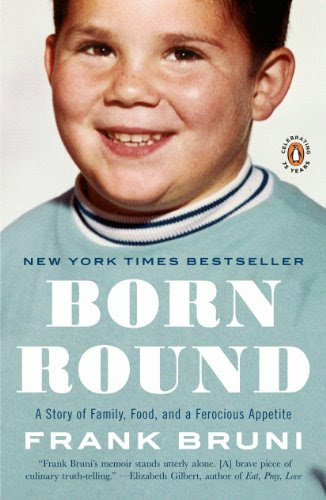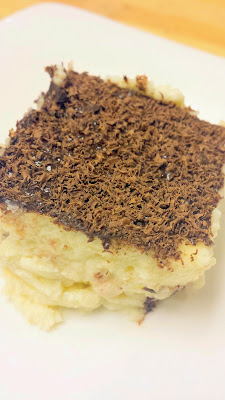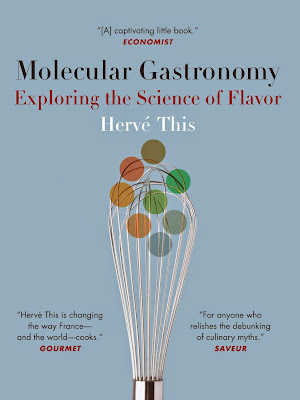For November the selected book subject for my online book club, The Kitchen Reader, was Born Round: A Story of Family, Food and a Ferocious Appetite by Frank Bruni. This memoir starts with how author Frank Bruni was born round / had a young childhood of being husky and loving food and promises to follow him through his youthful 20s to his heaviest of times (as a campaign correspondant, constantly on the road) to the point where most of us came to know the name of Frank Bruni: when he became the New York Times restaurant critic. The book promises to chronicle the struggle between someone who loves food but at the same time wants to be healthy – probably a tale so many of us know. What drew me in was not only that I knew he would become a famous restaurant critic, but that it was also the tale of that self-consciousness from a male perspective.

The first section of the book, Born Round, tells us the story of Frank from when he was a toddler bulimic who even at only in diapers wanted a third hamburger and had a ranked order of candy bars (Snickers beats 3 Musketeers because it has nuts, and Baby Ruth beats Snickers because it has more nuts, but KitKat ranked high because of its geometry and Reese’s Peanut Butter Cup for it’s beautiful orange wrapper). His memories of his childhood or full of food memories. It also touched on a very common start to the love of so much food- family.
It’s true of Asian families as well as Frank’s family heritage here (Italian) that big feasts are a way to provide sense of security and sign of success and love. I loved one particular description where he explained the family dinner traditions he inherited were a “violent, thrilling sport” and “were more like gastronomic rugby matches, dishes colliding, tomato sauce splattering, cutlets flying… and Grandma’s fervent belief that you had to make and serve enough of every dish to guarantee plenty of untouched, extra food on the table at the end of an endless dinner. If there wasn’t some of every kind of food you’d served left over, it meant that you had perhaps run out of something before someone had gotten his or her fill of it. There was no shame greater than that.”
As he followed up the story of Grandma glaring and banging pots and dishes and utensils louder and complimenting other family members who were eating her fried dough frits (Frank’s favorite were stuffed with mozzarella and tomato suace, so much better than any pizza that wore its soul on the surface unlike these secrets you had to eat your way into, he explained), Frank summarized simply “For her, food was a currency and communicator like no other, trumpeting pride, establishing wealth, proving love. It gave her what bearings she had in the world.”
His mother took up the mantle, Frank explained, “Food was how she showed people the amount of time she was willing to spare for them, the sorts of sacrifices she was willing to make for them. But while it was part courtesy, it was also part boast. She wanted to demonstrate what she could pull off.”
You can probably use Frank’s description there to summarize the relationship of food in any culture in that food is something everyone must do to survive and is thus universal. More than your home or your looks or your clothes, what you eat and serve your friends and family is more indicative of wealth and success and relationship that doesn’t require translation or understanding of history or culture. This chapter also includes lots of family photos, which really helps you connect fully with Frank and the story.
I salivated and craved Italian food as Frank explained the rivalry between his grandmother and sister-in-laws of the family in that each had dishes she was known for: a frittata dense with green and red peppers and locatelli Romano cheese; a breaded fried veal cutlets and homemade ravioli and orecchiette, a casserole of mezzani and thin slices of fried eggplant. As the next generation (Frank’s mother and Frank’s aunts) rose with their signature dishes, Frank described pizza dolce, a fluffy cheesecake made with ricotta, I couldn’t help but look it up and make a version myself (I share the recipe here!). I still have manicotti on the list for December, and maybe lasagna in January to make…
The second section, Yo-Yo Me, is when Frank goes into the details of the bulimic college years to the start of his 30s. This chapter is sometimes shallow, sometimes funny, sometimes sad but always frank and open… which what can you say, it is his 20s. It includes terrible but honest rationalizations and binge eating and other fad diets ranging from Metamucil and speed to diets of just all bread or just all salads. There is all the neurosis of dating less because of his perception of being flabby and disgusting, and the insecurities even when he did find some commitment for a while.
While women’s clothing certainly has an annoyance factor in that the same size in one store may not fit the same as in another store (and also often lack of functional pockets), Frank’s tale with tracking his waist sizes of his pants made me appreciate the kind of shame in the un-deniability of those numbers that are hidden by women’s clothing sizes and the larger variety of clothing like skirts, dresses, etc. to choose from. It was amusing to hear from a male perspective the idea of some clothing also being particularly flattering or having magical thinning powers though!
The third section, Ipso Fatso, goes into the circumstances as well as the mental and emotional mindset that brought Frank to his highest weight, combining the reality of aging family who pass away or who become distant as they begin their own families, the comfort of food when you are served possibly 8 potential meals on the campaign trail and exhausted from travel and deadlines. As Frank explains as he is now living in Manhattan with delivery menus where he would “spread the cartons and tins of food on the living room coffee table so I could survey and size up the bounty. I’d put on sweatpants and a baggy sweatshirt: nothing that could cinch or cling. I’d put something trashy and brainless on television… and the world would shrink to just a few square feet around me and to the warm, uncomplicated, unremarkable ripple of gratification running through me.”
It is quite a juxtaposition to hear someone who as I was reading his writing and hearing his voice, is obviously so intelligent, while playing mindgames with himself in trying a diet of only fruit, or hiding in baggy full of pockets jackets (even in July or August), or the way he treat himself with a last-hurrah opportunity of cravings before he started his big change – a last-hurrah meal he admitted happened as often as once a week. It was a mix of wonderful because he is so articulate and engaging while terribly both ridiculous and sad as you go through with him his lowest points.
Chapter 4, the last section, Critical Eating, is the falling action of this food vs weight story, where Frank begins to find the balance he needs. It probably is not a surprise that it’s about exercise as well as not binging – but the key is finding what exercise and what combination of food planning works for each individual. I did not expect that after 3/4 of the book essentially is about Frank not having any control over food that once he becomes a restaurant writer and for a living has to eat often and constantly, that the planning ahead and certainty of many future meals ends up freeing him to a great extent. And, his love of food never ceased – it was just how he acted on it.
Overall, the sincerity of this book communicates successfully his love of food and his journey from the harsh self-judgement to the acceptance of where he is happy to be. Sometimes the book does get hard to read in hearing the various details, but I think the different stories he tells to illustrate those time periods of his life may resonate differently with various readers – so he tells multiple, rather than concisely telling one to illustrate his point. You will probably do what I did- glaze over some that you are less interested in. But that doesn’t negate that there is some great charm in this book, even as he is writing about details of a disorder that are disturbing but treated so matter of fact. And, it’s proof that even with a happy family and childhood, everyone has their own life struggles to face beneath the surface of what you may see in public.
There is a whole section early in the first quarter dedicated to Thanksgiving. It’s a fine recounting, starting from T minus 6 days that starts with a ruled steno notebook and multiple pages of planned dishes and every ingredient to T minus 4 days the five hours to drive among all the right stores/unloading perishable. As T day approaches, there’s the creation of a detailed time line of what can be assembled and what must be prepared to individual Post-its for every bowl and pan and package. And on T day, recalling the start at 11:30 and the platters of appetizers (including four pounds of chilled shrimp prepared at 7 AM and at noon the fact carving takes an hour because not only do you make a turkey but a separate turkey breast to serve sandwiches later in the day (“You must serve sandwiches later in the day” Frank explained seriously, and you find out sandwich time is at 5:30, only 3 hours after the dessert table that includes 6 pies and more was served). Doggie bags begin at 7:30 PM. It seriously sounds like the best crazy Thanksgiving ever.
And if that detailed holiday meal wasn’t enough, at the end of reading this book you will really have a craving for some Italian food.















I agree whole heartedly about the honesty with which Bruni wrote. For me, his frankness (ha!) was what made me keep reading. The food describes was at times mouth-watering and at times very unappetising. I think your mention that “food was a communicator” for Frank’s family resonated with me. Don’t we all often do this: show our love and attention through food?